Testing and Software Life Cycle
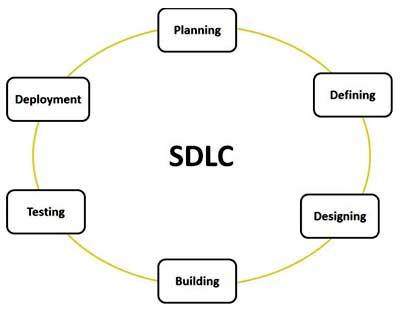
In testing process software development and testing life cycles plays a main role to organize the testing activities effectively. There are many different forms of testing. Because several disciplines, often with different interests are involved in the development life cycle, it is important to clearly understand and define the various test levels and types.
In software engineering, a software development methodology (also known as a system development methodology, software development life cycle, software development process, software process) is a division of software development work into distinct phases (or stages) containing activities with the intent of better planning and management. It is often considered a subset of the systems development life cycle. The methodology may include the pre-definition of specific deliverables and artefacts that are created and completed by a project team to develop or maintain an application.[1]
Common methodologies include waterfall, prototyping, iterative and incremental development, spiral development, rapid application development, extreme programming and agile methodology. Some people consider a life-cycle "model" a more general term for a category of methodologies and a software development "process" a more specific term to refer to a specific process chosen by a specific organization. For example, there are many specific software development processes that fit the spiral life-cycle model.
Software Development Models:
SDLC, Software Development Life Cycle is a process used by software industry to design, develop and test high quality software. The SDLC aims to produce high quality software that meets or exceeds customer expectations, reaches completion within times and cost estimates.
- SDLC is the acronym of Software Development Life Cycle.
- It is also called as Software development process.
- The software development life cycle (SDLC) is a framework defining tasks performed at each step in the software development process.
- ISO/IEC 12207 is an international standard for software life-cycle processes. It aims to be the standard that defines all the tasks required for developing and maintaining software.
What is SDLC?
SDLC is a process followed for a software project, within a software organization. It consists of a detailed plan describing how to develop, maintain, replace and alter or enhance specific software. The life cycle defines a methodology for improving the quality of software and the overall development process.
The following figure is a graphical representation of the various stages of a typical SDLC.
A typical Software Development life cycle consists of the following stages:
Stage 1: Planning and Requirement Analysis
Requirement analysis is the most important and fundamental stage in SDLC. It is performed by the senior members of the team with inputs from the customer, the sales department, market surveys and domain experts in the industry. This information is then used to plan the basic project approach and to conduct product feasibility study in the economical, operational, and technical areas.
Planning for the quality assurance requirements and identification of the risks associated with the project is also done in the planning stage. The outcome of the technical feasibility study is to define the various technical approaches that can be followed to implement the project successfully with minimum risks.
Stage 2: Defining Requirements
Once the requirement analysis is done the next step is to clearly define and document the product requirements and get them approved from the customer or the market analysts. This is done through .SRS. . Software Requirement Specification document which consists of all the product requirements to be designed and developed during the project life cycle.
Stage 3: Designing the product architecture
SRS is the reference for product architects to come out with the best architecture for the product to be developed. Based on the requirements specified in SRS, usually more than one design approach for the product architecture is proposed and documented in a DDS - Design Document Specification.
This DDS is reviewed by all the important stakeholders and based on various parameters as risk assessment, product robustness, design modularity , budget and time constraints , the best design approach is selected for the product.
A design approach clearly defines all the architectural modules of the product along with its communication and data flow representation with the external and third party modules (if any). The internal design of all the modules of the proposed architecture should be clearly defined with the minutes of the details in DDS.
Stage 4: Building or Developing the Product
In this stage of SDLC the actual development starts and the product is built. The programming code is generated as per DDS during this stage. If the design is performed in a detailed and organized manner, code generation can be accomplished without much hassle.
Developers have to follow the coding guidelines defined by their organization and programming tools like compilers, interpreters, debuggers etc are used to generate the code. Different high level programming languages such as C, C++, Pascal, Java, and PHP are used for coding. The programming language is chosen with respect to the type of software being developed.
Stage 5: Testing the Product
This stage is usually a subset of all the stages as in the modern SDLC models, the testing activities are mostly involved in all the stages of SDLC. However this stage refers to the testing only stage of the product where products defects are reported, tracked, fixed and retested, until the product reaches the quality standards defined in the SRS.
Stage 6: Deployment in the Market and Maintenance
Once the product is tested and ready to be deployed it is released formally in the appropriate market. Sometime product deployment happens in stages as per the organizations. Business strategy. The product may first be released in a limited segment and tested in the real business environment (UAT- User acceptance testing).
Then based on the feedback, the product may be released as it is or with suggested enhancements in the targeting market segment. After the product is released in the market, its maintenance is done for the existing customer base.
SDLC Models
There are various software development life cycle models defined and designed which are followed during software development process. These models are also referred as "Software Development Process Models". Each process model follows a Series of steps unique to its type, in order to ensure success in process of software development.
Following are the most important and popular SDLC models followed in the industry:
- Waterfall Model
- Iterative Model
- Spiral Model
- V-Model
- Big Bang Model
The other related methodologies are Agile Model, RAD Model, Rapid Application Development and Prototyping Models.
In every development life cycle, a part of testing is focused on verification testing and a part is focused on validation testing. Verification is concerned with evaluating a work product, component or system to determine whether it meets the requirement set. In fact verification focuses on the question “Is the deliverable built according to the specification? Validation is concerned with evaluating a work product, component or system to determine whether it meets the user needs and requirements. Validation focuses on the question ‘Is the user need and requirements. Validation focuses on the question ‘Is the deliverable fit for the purpose.
What is Verification?
Verification is a process of evaluating the intermediary work products of a software development lifecycle to check if we are in the right track of creating the final product.
Now the question here is: What are the intermediary products? Well, These can include the documents which are produced during the development phases like, requirements specification, design documents, data base table design, ER diagrams, test cases, traceability etc. We sometimes tend to neglect the importance of reviewing these documents but we should understand that reviewing itself can find out many hidden anomalies when if found or fixed in the later phase of development cycle, can be very costly.
In other words we can also state that verification is a process to evaluate the mediator products of software to check whether the products satisfy the conditions imposed during the beginning of the phase.
What is Validation?
Validation is the process of evaluating the final product to check whether the software meets the business needs. In simple words the test execution which we do in our day to day life are actually the validation activity which includes smoke testing, functional testing, regression testing, systems testing etc…
V-Model:
Before discussing the V-Model, we will look at the model which came before it. The water fall mode was one of the earliest models to be designed
Waterfall Model:
The Waterfall Model was first Process Model to be introduced. It is also referred to as a linear-sequential life cycle model. It is very simple to understand and use. In a waterfall model, each phase must be completed before the next phase can begin and there is no overlapping in the phases.
Waterfall model is the earliest SDLC approach that was used for software development.
The waterfall Model illustrates the software development process in a linear sequential flow; hence it is also referred to as a linear-sequential life cycle model. This means that any phase in the development process begins only if the previous phase is complete. In waterfall model phases do not overlap.
Waterfall Model design
Waterfall approach was first SDLC Model to be used widely in Software Engineering to ensure success of the project. In "The Waterfall" approach, the whole process of software development is divided into separate phases. In Waterfall model, typically, the outcome of one phase acts as the input for the next phase sequentially.
Following is a diagrammatic representation of different phases of waterfall model.
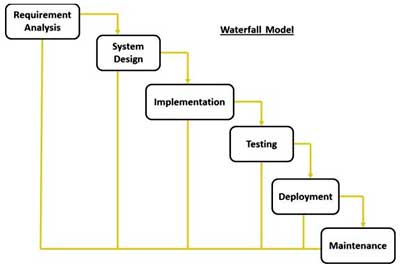
The sequential phases in Waterfall model are:
- Requirement Gathering and analysis: All possible requirements of the system to be developed are captured in this phase and documented in a requirement specification doc.
- System Design: The requirement specifications from first phase are studied in this phase and system design is prepared. System Design helps in specifying hardware and system requirements and also helps in defining overall system architecture.
- Implementation: With inputs from system design, the system is first developed in small programs called units, which are integrated in the next phase. Each unit is developed and tested for its functionality which is referred to as Unit Testing.
- Integration and Testing: All the units developed in the implementation phase are integrated into a system after testing of each unit. Post integration the entire system is tested for any faults and failures.
- Deployment of system: Once the functional and non functional testing is done, the product is deployed in the customer environment or released into the market.
- Maintenance: There are some issues which come up in the client environment. To fix those issues patches are released. Also to enhance the product some better versions are released. Maintenance is done to deliver these changes in the customer environment.
All these phases are cascaded to each other in which progress is seen as flowing steadily downwards (like a waterfall) through the phases. The next phase is started only after the defined set of goals are achieved for previous phase and it is signed off, so the name "Waterfall Model". In this model phases do not overlap.
Waterfall Model Application
Every software developed is different and requires a suitable SDLC approach to be followed based on the internal and external factors. Some situations where the use of Waterfall model is most appropriate are:
- Requirements are very well documented, clear and fixed.
- Product definition is stable.
- Technology is understood and is not dynamic.
- There are no ambiguous requirements.
- Ample resources with required expertise are available to support the product.
- The project is short.
The V-model was developed to address some of the problems experienced using the traditional waterfall model approach. Defects were being found too late in the life cycle, as testing was not involved until the end of the project. Testing also added lead time due to its late involvement. The V-model provides guidance that testing needs to begin as early as possible in the life cycles, which , as we have seen in chapter 1, is one of the fundamental principles of structured testing, It also shows that testing is not only as execution based activity. There are a variety of activities should be carried out in parallel with development activities, and testers need to work with development
Following is a diagrammatic representation of different phases of waterfall model.

The sequential phases in Waterfall model are:
- Requirement Gathering and analysis: All possible requirements of the system to be developed are captured in this phase and documented in a requirement specification doc.
- System Design: The requirement specifications from first phase are studied in this phase and system design is prepared. System Design helps in specifying hardware and system requirements and also helps in defining overall system architecture.
- Implementation: With inputs from system design, the system is first developed in small programs called units, which are integrated in the next phase. Each unit is developed and tested for its functionality which is referred to as Unit Testing.
- Integration and Testing: All the units developed in the implementation phase are integrated into a system after testing of each unit. Post integration the entire system is tested for any faults and failures.
- Deployment of system: Once the functional and non functional testing is done, the product is deployed in the customer environment or released into the market.
- Maintenance: There are some issues which come up in the client environment. To fix those issues patches are released. Also to enhance the product some better versions are released. Maintenance is done to deliver these changes in the customer environment.
SDLC Iterative Model
Following is the pictorial representation of Iterative and Incremental model:
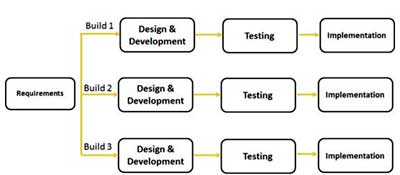
This model is most often used in the following scenarios:
- Requirements of the complete system are clearly defined and understood.
- Major requirements must be defined; however, some functionalities or requested enhancements may evolve with time.
- There is a time to the market constraint.
- A new technology is being used and is being learnt by the development team while working on the project.
- Resources with needed skill set are not available and are planned to be used on contract basis for specific iterations.
- There are some high risk features and goals which may change in the future.
SDLC Spiral Model
The spiral model has four phases. A software project repeatedly passes through these phases in iterations called Spirals.
- Identification: This phase starts with gathering the business requirements in the baseline spiral. In the subsequent spirals as the product matures, identification of system requirements, subsystem requirements and unit requirements are all done in this phase.
This also includes understanding the system requirements by continuous communication between the customer and the system analyst. At the end of the spiral the product is deployed in the identified market. - Design: Design phase starts with the conceptual design in the baseline spiral and involves architectural design, logical design of modules, physical product design and final design in the subsequent spirals.
- Construct or Build: Construct phase refers to production of the actual software product at every spiral. In the baseline spiral when the product is just thought of and the design is being developed a POC (Proof of Concept) is developed in this phase to get customer feedback.
Then in the subsequent spirals with higher clarity on requirements and design details a working model of the software called build is produced with a version number. These builds are sent to customer for feedback. - Evaluation and Risk Analysis: Risk Analysis includes identifying, estimating, and monitoring technical feasibility and management risks, such as schedule slippage and cost overrun. After testing the build, at the end of first iteration, the customer evaluates the software and provides feedback.
Following is a diagrammatic representation of spiral model listing the activities in each phase:
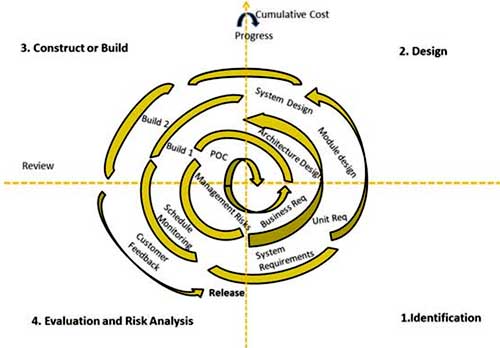
V Model
The V - model is SDLC model where execution of processes happens in a sequential manner in V-shape. It is also known as Verification and Validation model.
V - Model is an extension of the waterfall model and is based on association of a testing phase for each corresponding development stage. This means that for every single phase in the development cycle there is a directly associated testing phase. This is a highly disciplined model and next phase starts only after completion of the previous phase.
The below figure illustrates the different phases in V-Model of SDLC.
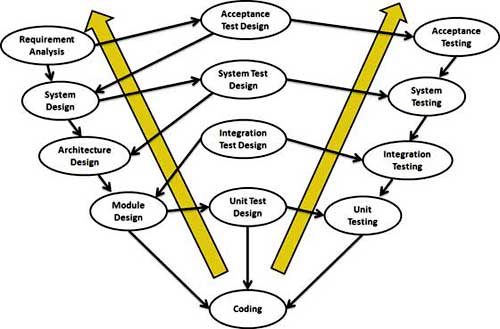
SDLC Big Bang Model
The Big Bang model is SDLC model where there is no specific process followed. The development just starts with the required money and efforts as the input, and the output is the software developed which may or may not be as per customer requirement.
B if Bang Model is SDLC model where there is no formal development followed and very little planning is required. Even the customer is not sure about what exactly he wants and the requirements are implemented on the fly without much analysis.
Usually this model is followed for small projects where the development teams are very small.
Agile Model
Here is a graphical illustration of the Agile Model:

Agile thought process had started early in the software development and started becoming popular with time due to its flexibility and adaptability.
The most popular agile methods include Rational Unified Process (1994), Scrum (1995), Crystal Clear, Extreme Programming (1996), Adaptive Software Development, Feature Driven Development, and Dynamic Systems Development Method (DSDM) (1995). These are now collectively referred to as agile methodologies, after the Agile Manifesto was published in 2001.
Following are the Agile Manifesto principles
- Individuals and interactions. In agile development, self-organization and motivation are important, as are interactions like co-location and pair programming.
- Working software. Demo working software is considered the best means of communication with the customer to understand their requirement, instead of just depending on documentation.
- Customer collaboration. As the requirements cannot be gathered completely in the beginning of the project due to various factors, continuous customer interaction is very important to get proper product requirements.
- Responding to change. Agile development is focused on quick responses to change and continuous development.
RAD Model
Following image illustrates the RAD Model:

Following are the typical scenarios where RAD can be used:
- RAD should be used only when a system can be modularized to be delivered in incremental manner.
- It should be used if there’s high availability of designers for modelling.
- It should be used only if the budget permits use of automated code generating tools.
- RAD SDLC model should be chosen only if domain experts are available with relevant business knowledge.
- Should be used where the requirements change during the course of the project and working prototypes are to be presented to customer in small iterations of 2-3 months.
Software Prototyping
The Software Prototyping refers to building software application prototypes which display the functionality of the product under development but may not actually hold the exact logic of the original software.
Software prototyping is becoming very popular as a software development model, as it enables to understand customer requirements at an early stage of development. It helps get valuable feedback from the customer and helps software designers and developers understand about what exactly is expected from the product under development.
Following is the stepwise approach to design a software prototype:
- Basic Requirement Identification: This step involves understanding the very basics product requirements especially in terms of user interface. The more intricate details of the internal design and external aspects like performance and security can be ignored at this stage.
- Developing the initial Prototype: The initial Prototype is developed in this stage, where the very basic requirements are showcased and user interfaces are provided. These features may not exactly work in the same manner internally in the actual software developed and the workarounds are used to give the same look and feel to the customer in the prototype developed.
- Review of the Prototype: The prototype developed is then presented to the customer and the other important stakeholders in the project. The feedback is collected in an organized manner and used for further enhancements in the product under development.
- Revise and enhance the Prototype: The feedback and the review comments are discussed during this stage and some negotiations happen with the customer based on factors like, time and budget constraints and technical feasibility of actual implementation. The changes accepted are again incorporated in the new Prototype developed and the cycle repeats until customer expectations are met.
Software Testing Levels:
A thought of understanding and defining of the various test levels will identify missing areas and prevent overlap and reputation. Sometimes we may wish to introduce deliberate overlap to address specific risks. Understanding weather we want overlaps and removing the gaps will make the test levels more complementary thus leading to more effective and efficient testing
There are different levels during the process of testing. In this chapter, a brief description is provided about these levels.
Levels of testing include different methodologies that can be used while conducting software testing. The main levels of software testing are:
- Functional Testing
- Non-functional Testing
Functional Testing
This is a type of black-box testing that is based on the specifications of the software that is to be tested. The application is tested by providing input and then the results are examined that need to conform to the functionality it was intended for. Functional testing of software is conducted on a complete, integrated system to evaluate the system's compliance with its specified requirements.
There are five steps that are involved while testing an application for functionality.
| Steps | Description |
| I | The determination of the functionality that the intended application is meant to perform. |
| II | The creation of test data based on the specifications of the application. |
| III | The output based on the test data and the specifications of the application. |
| IV | The writing of test scenarios and the execution of test cases. |
| V | The comparison of actual and expected results based on the executed test cases. |
An effective testing practice will see the above steps applied to the testing policies of every organization and hence it will make sure that the organization maintains the strictest of standards when it comes to software quality.
Unit Testing
This type of testing is performed by developers before the setup is handed over to the testing team to formally execute the test cases. Unit testing is performed by the respective developers on the individual units of source code assigned areas. The developers use test data that is different from the test data of the quality assurance team.
The goal of unit testing is to isolate each part of the program and show that individual parts are correct in terms of requirements and functionality.
Limitations of Unit Testing
Testing cannot catch each and every bug in an application. It is impossible to evaluate every execution path in every software application. The same is the case with unit testing.
There is a limit to the number of scenarios and test data that a developer can use to verify a source code. After having exhausted all the options, there is no choice but to stop unit testing and merge the code segment with other units.
Integration Testing
Integration testing is defined as the testing of combined parts of an application to determine if they function correctly. Integration testing can be done in two ways: Bottom-up integration testing and Top-down integration testing.
| S.N. | Integration Testing Method |
| 1 | Bottom-up integration This testing begins with unit testing, followed by tests of progressively higher-level combinations of units called modules or builds. |
| 2 | Top-down integration In this testing, the highest-level modules are tested first and progressively, lower-level modules are tested thereafter. |
In this testing, the highest-level modules are tested first and progressively, lower-level modules are tested thereafter.
In a comprehensive software development environment, bottom-up testing is usually done first, followed by top-down testing. The process concludes with multiple tests of the complete application, preferably in scenarios designed to mimic actual situations.
System Testing
System testing tests the system as a whole. Once all the components are integrated, the application as a whole is tested rigorously to see that it meets the specified Quality Standards. This type of testing is performed by a specialized testing team.
System testing is important because of the following reasons:
- System testing is the first step in the Software Development Life Cycle, where the application is tested as a whole.
- The application is tested thoroughly to verify that it meets the functional and technical specifications.
- The application is tested in an environment that is very close to the production environment where the application will be deployed.
- System testing enables us to test, verify, and validate both the business requirements as well as the application architecture.
Regression Testing
Whenever a change in a software application is made, it is quite possible that other areas within the application have been affected by this change. Regression testing is performed to verify that a fixed bug hasn't resulted in another functionality or business rule violation. The intent of regression testing is to ensure that a change, such as a bug fix should not result in another fault being uncovered in the application.
Regression testing is important because of the following reasons:
- Minimize the gaps in testing when an application with changes made has to be tested.
- Testing the new changes to verify that the changes made did not affect any other area of the application.
- Mitigates risks when regression testing is performed on the application.
- Test coverage is increased without compromising timelines.
- Increase speed to market the product.
Acceptance Testing
This is arguably the most important type of testing, as it is conducted by the Quality Assurance Team who will gauge whether the application meets the intended specifications and satisfies the client’s requirement. The QA team will have a set of pre-written scenarios and test cases that will be used to test the application.
More ideas will be shared about the application and more tests can be performed on it to gauge its accuracy and the reasons why the project was initiated. Acceptance tests are not only intended to point out simple spelling mistakes, cosmetic errors, or interface gaps, but also to point out any bugs in the application that will result in system crashes or major errors in the application.
By performing acceptance tests on an application, the testing team will deduce how the application will perform in production. There are also legal and contractual requirements for acceptance of the system.
Alpha Testing
This test is the first stage of testing and will be performed amongst the teams (developer and QA teams). Unit testing, integration testing and system testing when combined together are known as alpha testing. During this phase, the following aspects will be tested in the application:
- Spelling Mistakes
- Broken Links
- Cloudy Directions
- The Application will be tested on machines with the lowest specification to test loading times and any latency problems.
Beta Testing
This test is performed after alpha testing has been successfully performed. In beta testing, a sample of the intended audience tests the application. Beta testing is also known as pre-release testing. Beta test versions of software are ideally distributed to a wide audience on the Web, partly to give the program a "real-world" test and partly to provide a preview of the next release. In this phase, the audience will be testing the following:
- Users will install, run the application and send their feedback to the project team.
- Typographical errors, confusing application flow, and even crashes.
- Getting the feedback, the project team can fix the problems before releasing the software to the actual users.
- The more issues you fix that solve real user problems, the higher the quality of your application will be.
- Having a higher-quality application when you release it to the general public will increase customer satisfaction.
Non-Functional Testing
This section is based upon testing an application from its non-functional attributes. Non-functional testing involves testing software from the requirements which are non-functional in nature but important such as performance, security, user interface, etc.
Some of the important and commonly used non-functional testing types are discussed below.
Performance Testing
It is mostly used to identify any bottlenecks or performance issues rather than finding bugs in software. There are different causes that contribute in lowering the performance of software:
- Network delay
- Client-side processing
- Database transaction processing
- Load balancing between servers
- Data rendering
Performance testing is considered as one of the important and mandatory testing type in terms of the following aspects:
- Speed (i.e. Response Time, data rendering and accessing)
- Capacity
- Stability
- Scalability
Performance testing can be either qualitative or quantitative and can be divided into different sub-types such as Load testing and Stress tests.
Load Testing
It is a process of testing the behaviour of software by applying maximum load in terms of software accessing and manipulating large input data. It can be done at both normal and peak load conditions. This type of testing identifies the maximum capacity of software and its behaviour at peak time.
Most of the time, load testing is performed with the help of automated tools such as Load Runner, Applauder, IBM Rational Performance Tester, Apache Meter, Silk Performer, Visual Studio Load Test, etc.
Virtual users (Users) are defined in the automated testing tool and the script is executed to verify the load testing for the software. The number of users can be increased or decreased concurrently or incrementally based upon the requirements.
Stress Testing
Stress testing includes testing the behaviour of software under abnormal conditions. For example, it may include taking away some resources or applying a load beyond the actual load limit.
The aim of stress testing is to test the software by applying the load to the system and taking over the resources used by the software to identify the breaking point. This testing can be performed by testing different scenarios such as:
- Shutdown or restart of network ports randomly
- Turning the database on or off
- Running different processes that consume resources such as CPU, memory, server, etc.
Usability Testing
Usability testing is a black-box technique and is used to identify any error(s) and improvements in the software by observing the users through their usage and operation.
According to Nielsen, usability can be defined in terms of five factors, i.e. efficiency of use, learn-ability, memory-ability, errors/safety, and satisfaction. According to him, the usability of a product will be good and the system is usable if it possesses the above factors.
Nigel Bevan and Macleod considered that usability is the quality requirement that can be measured as the outcome of interactions with a computer system. This requirement can be fulfilled and the end-user will be satisfied if the intended goals are achieved effectively with the use of proper resources.
Mulish in 2000 stated that a user-friendly system should fulfil the following five goals, i.e., easy to Learn, easy to remember, efficient to use, satisfactory to use, and easy to understand.
In addition to the different definitions of usability, there are some standards and quality models and methods that define usability in the form of attributes and sub-attributes such as ISO-9126, ISO-9241-11, ISO-13407, and IEEE std.610.12, etc.
UI vs. Usability Testing
UI testing involves testing the Graphical User Interface of the Software. UI testing ensures that the GUI functions according to the requirements and tested in terms of colour, alignment, size, and other properties.
On the other hand, usability testing ensures a good and user-friendly GUI that can be easily handled. UI testing can be considered as a sub-part of usability testing.
Security Testing
Security testing involves testing software in order to identify any flaws and gaps from security and vulnerability point of view. Listed below are the main aspects that security testing should ensure:
- Confidentiality
- Integrity
- Authentication
- Availability
- Authorization
- Non-repudiation
- Software is secure against known and unknown vulnerabilities
- Software data is secure
- Software is according to all security regulations
- Input checking and validation
- SQL insertion attacks
- Injection flaws
- Session management issues
- Cross-site scripting attacks
- Buffer overflows vulnerabilities
- Directory traversal attacks
Portability Testing
Portability testing includes testing software with the aim to ensure its reusability and that it can be moved from software as well. Following are the strategies that can be used for portability testing:
- Transferring installed software from one computer to another.
- Building executable (.exe) to run the software on different platforms.
Portability testing can be considered as one of the sub-parts of system testing, as this testing type includes overall testing of software with respect to its usage over different environments. Computer hardware, operating systems, and browsers are the major focus of portability testing. Some of the pre-conditions for portability testing are as follows:
- Software should be designed and coded, keeping in mind the portability requirements.
- Unit testing has been performed on the associated components.
- Integration testing has been performed.
- Test environment has been established.






